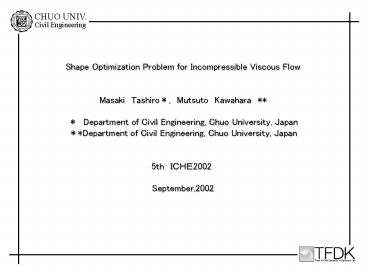Shape Optimization Problem for Incompressible Viscous Flow - PowerPoint PPT Presentation
1 / 19
Title:
Shape Optimization Problem for Incompressible Viscous Flow
Description:
Department of Civil Engineering, Chuo University, Japan ... Vorticity. Normal derivative. NUMERICL EXAMPLE. CHUO UNIV. Civil Engineering. Iteration history ... – PowerPoint PPT presentation
Number of Views:38
Avg rating:3.0/5.0
Title: Shape Optimization Problem for Incompressible Viscous Flow
1
Shape Optimization Problem for Incompressible
Viscous Flow Masaki Tashiro, Mutsuto Kawahara
Department of Civil Engineering, Chuo
University, Japan Department of Civil
Engineering, Chuo University, Japan 5th
ICHE2002 September,2002
2
- Introduction
- Lagrange multiplier method
- Gradient method
- Numerical example
- Conclusion and Future work
3
What is the shape which has minimum drag force?
4
Incompressible Stokes equation
5
APPROXIMATION
PSPG formulation
The weighiting residiual equation of the PSPG
formulation can be denoted by adding the
stability term of the Petrov-Galerkin formulation
to the Galerkin formulation.
The stability parameter is defined in each
element.
6
APPROXIMATION
Finite element equation
7
FORMULATION
Performance function
Fluid forces are directly applied to the
performance function.
F1 Drag forces F2 Lift forces
8
The volume is being kept in each minimization
iteration step. To keep the volume of the body is
equal to keep the volume of the whole analytical
domain.
9
FORMULATION
Lagrange multiplier method
Shape optimization problem with constraint
condition can be transformed to the minimization
problem of the extended performance function.
10
FORMULATION
The stationary condition of the extended
performance function can be derived from the
first variation of that.
11
FORMULATION
Adjoint equation
When the state and adjoint values are solved, the
optimal condition of this problem is given as
follows.
12
FORMULATION
Gradient of the extended performance function
13
MINIMIZATION
Gradient algorithm
New shape is found by deforming the surface
according to
14
THE PROCESS OF OPTIMALSHAPE
15
NUMERICAL EXAMPLE
Objective Drag minimization problem Constraint
conditionArea of body is constant Initial
shape Circle
16
NUMERICL EXAMPLE
Finite element mesh of optimal shape
Pressure distribution of optimal shape
17
NUMERICL EXAMPLE
Vorticity
Normal derivative
18
NUMERICL EXAMPLE
Iteration history
19
- Numerical determination of minimum drag shape
- in an incompressible flow was attempted.
- The body shape that satisfied the necessary
condition was obtained. - The present method can be applied to other flow..




























![Blood Flow Measurement Devices Market Report [2016-2021] PowerPoint PPT Presentation](https://s3.amazonaws.com/images.powershow.com/9400200.th0.jpg?_=20200217018)


